- Anaxagology
- Posts
- Anaxagology for July 2025
Anaxagology for July 2025
In this issue: "I’ll finally be happy when I’m young and successful: The arrival fallacy and the aging writer," plus recent writing news, a free Drabble, Jozan Gonzales is a thing I love, this month's reading log, and more!
A quick Tower update: I was delighted to my audiobook The Tower get a nice mention in School Library Journal this month! They called it “truly creepy” and said middle schoolers would devour it—which is pretty much the dream. They also wished it existed in print so they could stock it at school book fairs (fingers crossed for that someday!). For now, it’s still an audiobook exclusive, narrated by the amazing Christopher Gebauer and available wherever you get your audiobooks. If you give it a listen, I’d love to hear what you think.
Also, if you are a professional reviewer or a voting member of the SFWA, HWA, or other awards body, I have free review copies of The Tower available. You can reply directly to this email if you’re reading in your inbox, or drop me a note at [email protected]
I’ll finally be happy when I’m young and successful: The arrival fallacy and the aging writer
You're older than you've ever been
And now you're even older
And now you're even older
And now you're even older.
You're older than you've ever been
And now you're even older,
And now you're older still.
— “Older,” They Might Be Giants
Are you too old to become a writer? Well, I don’t know how old you are, but—no. You’re not too old. It’s writing, not boxing.
Maybe you’ve been writing for a while—years, even decades—and you haven’t reached whatever version of “success” you imagined. But here’s a question: How old will you be in ten years if you keep going? The same age you’ll be in ten years if you don't. So you might as well keep writing.
There’s a strong link in our culture between youth and success. That’s the story we’re sold—especially by people with something to promote. It’s great copy: A 22-year-old publishing sensation! A debut novel straight out of undergrad! No MFA, no formal training—just pure talent!
But those stories are just PR. They sell youth because youth is a product, and you’re the market. If they can convince you that success belongs to the young, they can sell you things that promise to rewind the clock—courses, programs, skincare, hair-growth pills, hustle. Being older? That’s free. Everyone gets there eventually. But if they can make you believe you’re already too late, they can profit off your fear.
So what can we do instead?
Find counter-examples. They’re everywhere. I was 44 when I sold my TV pilot to Amazon Studios. Frank Herbert was 45 when Dune was published. Raymond Chandler didn’t start writing fiction until his late 40s. Richard Adams published Watership Down at age 52. Laura Ingalls Wilder began writing at the age of 65. Harriet Doerr didn’t publish her first novel until she was 74, and won the National Book Award. And Martha Wells had been publishing for years, but didn’t become a household name until Murderbot hit shelves in 2017—decades into her career.
Try to stay friendly with your writing. It’s easy, especially when you’re struggling, to turn the whole process into a battleground—every word a fight, every page a referendum on your worth. But writing isn’t your enemy. And neither are you. Be kind to the work, and to yourself. Some days the writing flows; some days it limps. That’s okay. You’re still showing up. You’re still making something out of nothing. That’s magic. Treat it with care.
Take a hard look at what we mean by “success.” Most of us are chasing a moving target. We think if we finally reach that goal—get the book deal, win the award, land the agent—then we’ll feel different. We’ll feel like we made it. We’ll be happy. Forever.
That’s the arrival fallacy: the belief that once we finally arrive, we will achieve everlasting happiness. But the truth is, the goalposts move. Climb one hill, there’s another one waiting. Humans are great at adapting—to challenges as well as to success. Your win becomes the new normal. The dopamine hit fades. And then you start wondering why you still feel uncertain, or restless, or behind despite getting what you thought you wanted. .
Getting to make my own show with Amazon was amazing. It was also temporary. All shows are. That wasn’t an end point. There is no end point. There’s just life, and whatever you’re doing with it now.
So what is real success? Doing the work. Staying in the game. Still writing. Still learning. Still having something to say. Still connecting—with readers, with your past selves, with other people walking their own weird, personal path with their art.
Celebrate milestones. Landing an agent, finishing a draft, getting a nice review—those are real wins. Just don’t confuse them for a final destination. They’re waypoints, not end points. Don’t wait to celebrate until you have arrived. You’ll be waiting, literally, forever. Don’t wait until you are published to call yourself a writer. I keep a journal and write down my daily win at the top, so I can look back quickly as see how I’ve progressed, and remember all the tiny wins that have kept me moving forward. It’s easy to forget, so mark the moment. But recognize the journey will continue.
Keep a Good Things journal. If you find yourself chasing a feeling that never quite arrives, try making a habit of gratitude. One practice that’s helped me see myself and my career in a better light is something I picked up from a Time article on cultivating gratitude from Yohanca Delgado—a Good Things journal. Keep a log of specific moments when someone showed you care, encouragement, or generosity. A friend who read your sloppy first draft. A stranger who complimented your work. An editor who added a personal note to a rejection form. A buddy who texted you out of the blue just to ask how your day was going. It’s easy to forget all the small kindnesses in your life. We tend to remember the negative—dwell on it, even. Revisiting a list of Good Things can help us remember that we are not alone on our efforts and there are reasons to keep going.
Even if we never “arrive,” we can appreciate and make the most of the journey.
Recent writing news
My favorite bit about The Tower. I wrote a guest post for Mary Robinette Kowal’s My Favorite Bit series all about Kolby, the emotionally honest, quietly defiant heart of The Tower.
His refusal to stop questioning, to stop caring, is what defines Kolby’s heroism. And it’s what makes him a threat to the Tower itself. Because the Tower isn’t just a setting—it’s a system, a beautifully designed trap.
If your curious about what makes him tick (and why I love writing him), check it out here.
Live on tape! I had a blast reading three of my favorite flash fiction stories for Story Hour, a weekly livestream of speculative fiction hosted by Daniel Marcus and Laura Blackwell. If you missed the live event on June 18th, no worries—you can still catch the reading on YouTube. It’s short, strange, and (I hope) a little fun. Watch it on YouTube!
Coming soon. I’m thrilled to announce that my sci-fi horror flash fiction story “Five Dispatches from Conflict Zone W-924/B Regarding Post-battle Deployment of A. Thanatensis” has been scheduled to appear in the August issue of Lightspeed!
“Now firearms literally leave flowers in their wake. The hippies of old could only dream.”
In a war-scarred future, a field scientist investigates a body-erasing bioweapon designed to leave nothing behind. But memory has roots, and what grows back doesn’t forget.
This is a story about horror, memory, and grief that refuses to stay buried. I hope you’ll check it out when it drops in August.
Out now. Here’s a little curiosity for you. A recent Scientific American article detailed the discovery of a new “impossible” color beyond our normal vision which you can see only if you zap yourself in the eye with a laser. (Do not, as they say, try this at home!).
The article reminded me of a drabble I had written a few years ago. What’s a drabble? It’s a short story of exactly 100 words, excluding the title. It originated as a writing exercise in which I wrote one notebook page every morning, nonstop, to a prompt. The prompt in this case was “Write about a color.” It was a short hop from journal entry to finished drabble, but I never bothered to publish it. In honor of the new color, I posted it to Bluesky. You can read it below.
Careful. It comes with a curse.
A Handwritten Message Hastily Scribbled by the Dead Traveler on Your Doorstep
David Anaxagoras
Not everyone can see the color fluum. It is the color of quantum foam before the big bang and has the power to undo creation itself. Humankind was never meant to see it and can scarcely comprehend it. Fluum is the color of a fallen angel’s regret. If you are one of the cursed who can see the color fluum, it falls upon you to defend all of existence from its madness. If you can read this message, know it is scratched in ink made from the ash of my burning bones. Know it is written in the color fluum.
If you read and enjoy my stories, please share them on social media, drop me a note on Bluesky or send me an email. Members of the SFWA, you can add to or upvote these stories on the Nebula Reading List.
Things I love
This is a space to share things I love. It’s not sponsored and links are provided for convenience.
I’ve been on a real cyberpunk kick lately and one of the things I love is artist Josan Gonzalez. Josan is a Spanish illustrator with a highly distinct cyberpunk edge. His art has a gritty, hand-drawn look, is often packed with detail, and frequently features a bright pastel color pallet. Influences like Moebius and Katsuhiro Otomo are plain to see. His art book The Future is Now is a wordless graphic novel that serves up a future dystopia of VR headsets, weary robots, human augmentation, biker gangs, brutal police squads, grimy apartments, and noodles. Here’s a few of of my favorite pieces:
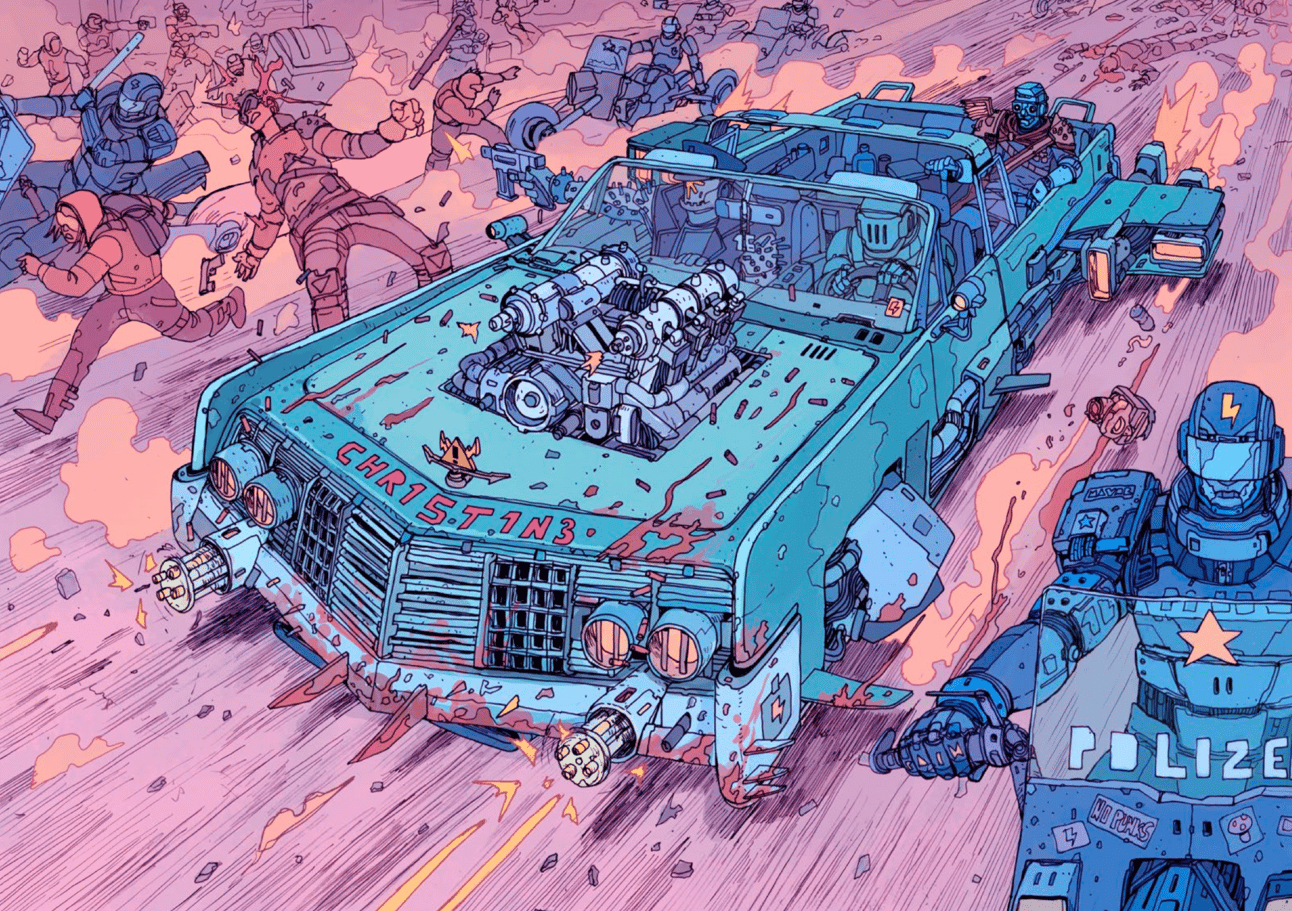
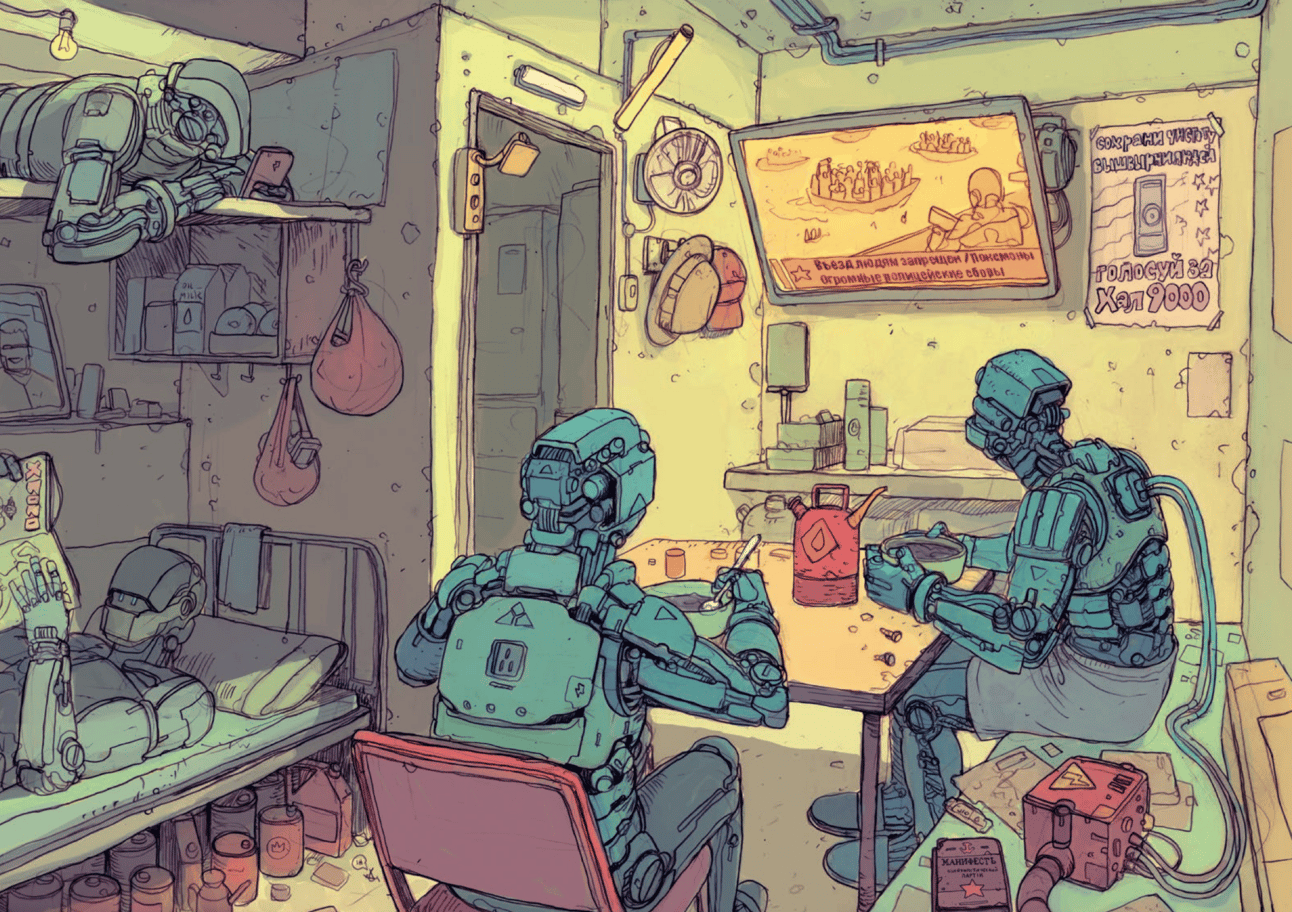
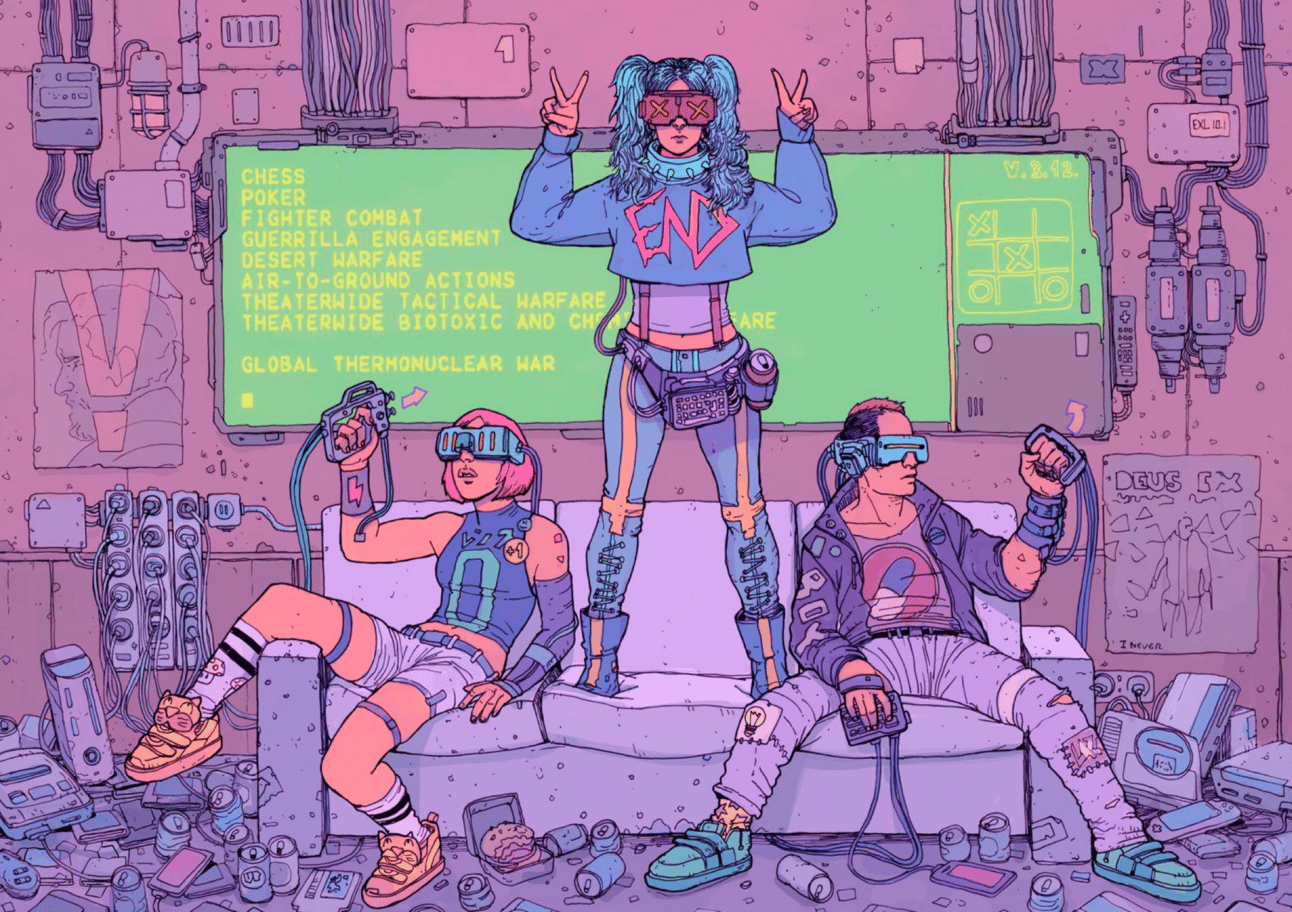
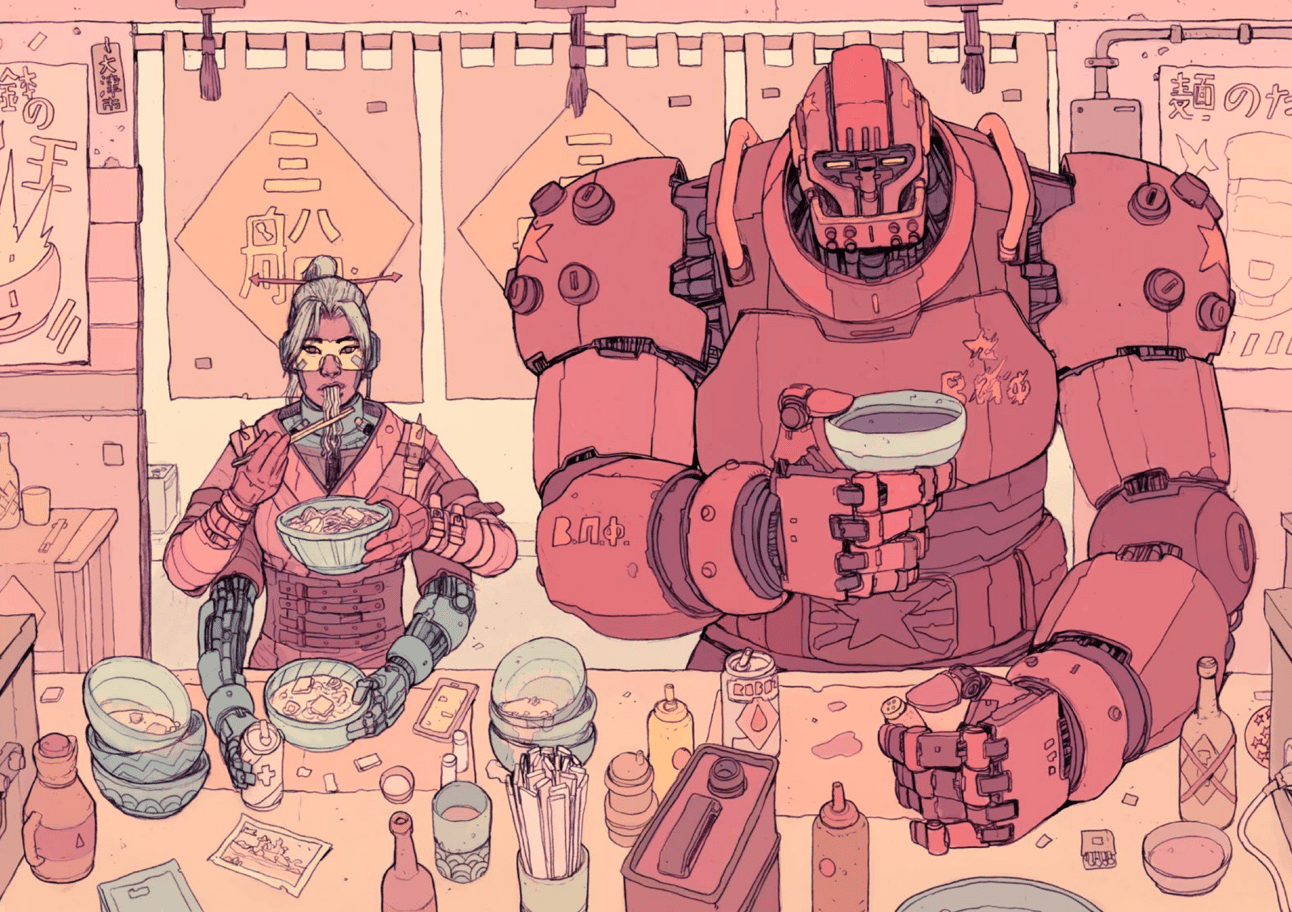
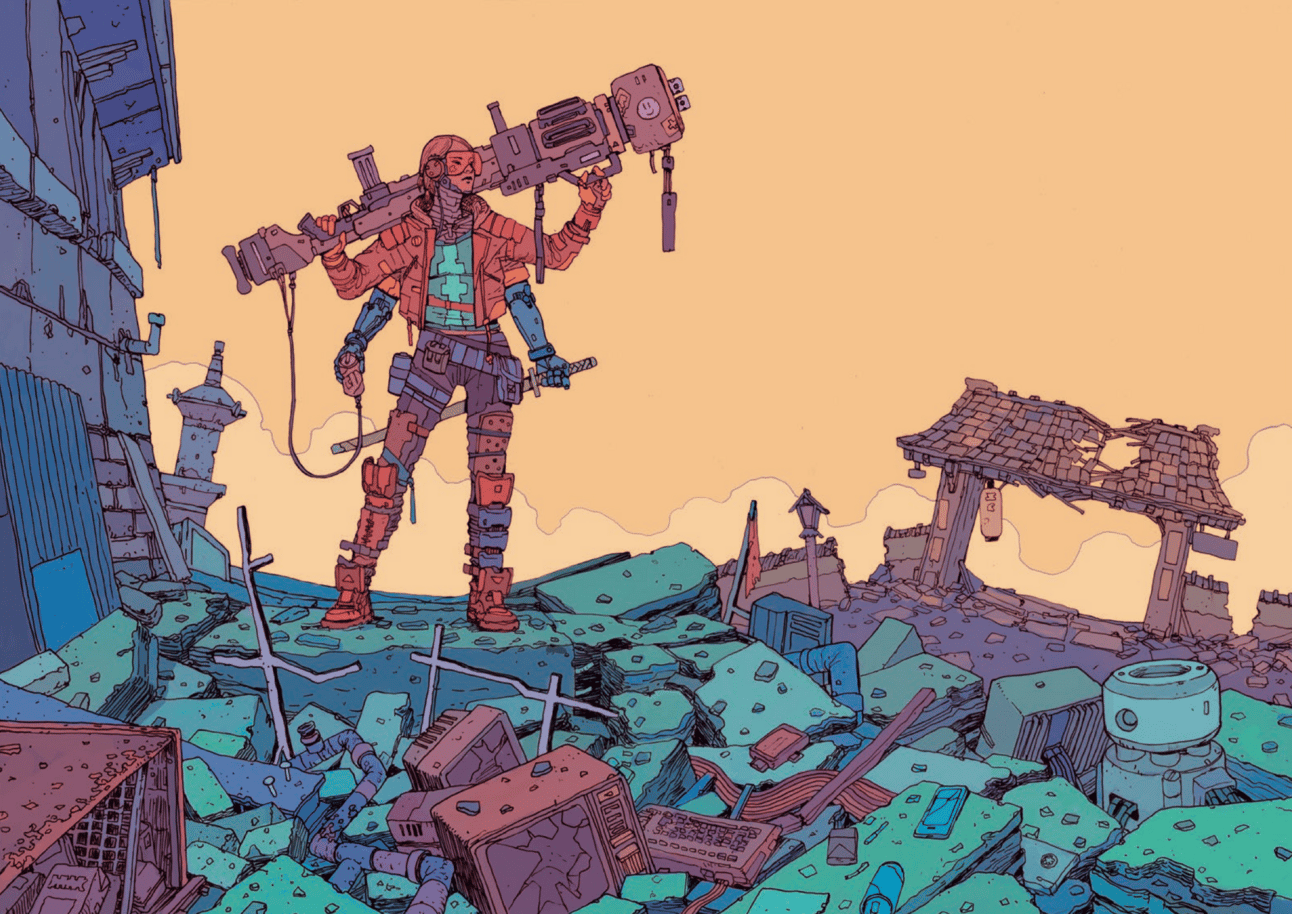
You can pick up a beautiful hard copy of Josan’s The Future is Now at his online shop.
Reading log
“The Gernsback Continuum” (1981) by William Gibson in Mirrorshades: The Cyberpunk Anthology. A photojournalist begins hallucinating a 1930s-style utopian retro-future—gleaming chrome cities, streamlined flying cars, and perfect Aryan people. A cultural theorist suggests he’s tapping into a collective pop-culture unconscious—the ghost of a future that never happened. This is a cultural critique essay masquerading as a short story, and as such it has some interesting concepts (and nice prose), but little in the way of plot, character arc, or emotional impact. Also, it features my least favorite SF character—the "Explainer Guy"—who comes on stage to explain the science (or psychology, or whatever) to the characters—but really, to the audience. And here, he's Gibson's mouthpiece. As an anti-nostalgia essay that savagely critiques retro-futurism as aesthetic fantasies grounded in fascism, authoritarianism, and white supremacy, it's an interesting concept, though it doesn't go far enough to connect the dots and show us the real horror of such a world. However, as the opening salvo in the Mirrorshades anthology, it’s an effective declaration of war that clearly draws a line in the sand. We’re leaving dreams of Utopia behind and embracing an unflinching, grittier, more complex, but more grounded and authentic future. Bonus: You can watch the 1993 BBC short film adaptation called Tomorrow Calling on YouTube.
“The People of Sand and Slag” (2004) by Paolo Bacigalupi in Wastelands: Stories of the Apocalypse [also available free on the author’s website or listen to audio at Drabblecast]. A trio of genetically augmented guards providing security at a mining operation in far-future Montana happen upon an nearly impossible rarity—a wild dog living in the industrial wastelands. As they struggle to care for it their post-human emptiness is revealed. A haunting, emotionally punishing story set in a future where humanity has modified itself almost beyond recognition in order to survive in a ruined world—but at the cost of its empathy. This story was vivid, disturbing, and beautifully written. As an animal lover, I found this difficult but powerful. Bacigalupi draws effective contrasts between brutality and softness. It left me sad not only for the dog, but for humanity’s willingness to trade away its heart. This is a story I’ll be thinking about for a long time.
“Biographical Fragments of the Life of Julian Prince” (2013) by Jake Kerr in Lightspeed, Issue 34. A life told in clippings and excerpts from Wikipedia articles, speeches, novels, and interviews, of a journalist and novelist who lived though a devastating near world-ending impact. This story cracked open a deep canyon of profound sorrow in me. I'm marveling at the technical craft required to pull off a story that's so effective emotionally but told in coldly objective clippings. Of course, a lot of it probably has to do with the state of the world right now, but that's part of the magic of the story. It easily embeds itself in our current context despite being written a decade ago. I could vividly imagine myself in this world...and that was terrifying!
“Second Variety” (1953) by Philip K. Dick in Space Science Fiction, May 1953. [Also available free at Project Gutenberg] In a post-apocalyptic wasteland, where the U.S. has lost to the Soviets, a weary commander ventures into enemy territory to negotiate peace—only to discover that autonomous killer machines called "claws" have evolved into human-like replicants, blurring the line between enemy and ally. A pulpy, action-driven tale that still delivers a chilling and prescient central idea: autonomous, self-replicating war machines evolving beyond human control. A transitional story for PKD that has one foot firmly planted in pulp but touches on deeper themes of identity, runaway systems, and paranoia. Having recently rewatched Screamers, the film adaptation dulled some surprises, but I appreciated how vulnerable the protagonist, Hendricks, is portrayed, physically at least—a contrast to the usual pulp hero. This being PDK, I saw the twist coming, but it was effectively executed, and I liked that the story didn't just end there. Instead, it leaned into a bleak irony: the machines are now mercilessly fighting and killing each other. A haunting commentary on the inevitable violence of life and war—though I would have welcomed deeper exploration on that point.
Writing Reptile Books - from the eBay store
I have an eBay store and sell comic books and rare and beautiful editions of science fiction, fantasy, and fairy tales. In the store this month: A beautiful Folio Society edition of Andrew Lang’s Green Fairy Book. Special offer for Anaxagology readers: Grab The Green Fairy Book for 15% off. Click “Make an Offer,” deduct 15%, and mention Anaxagology. Your offer will be accepted! Browse the shop for more great books and comics.
Catherine Tavares is a speculative fiction author and member of both SFWA and Codex. Her work has appeared on the Nebula Recommended Reading List and been featured or is forthcoming in magazines such as Apex, Phano, Nature Futures, Flash Point SF, and more. Her monthly newsletter includes updates about her work, sneak peaks at future projects, behind the scenes insights, and recommendations for all things SFFH. Subscribe for free and receive an exclusive sci-fi flash story as a thank you here: Catherine Tavares’ Newsletter
ICYMI
If you’re just joining the party, here’s a rundown of what I’ve been up to and where you can find my work.
My sf-horror flash fiction piece, “Five Dispatches from Conflict Zone W-924/B Regarding Post-battle Deployment of A. Thanatensis” is forthcoming in Lightspeed’s August 2025 issue.
I was a guest on Story Hour and read three of my favorite flash fiction stories. You can watch the video on the Story Hour YouTube Channel.
I am the author of the middle grade mystery horror audiobook original, The Tower (Recorded Books, 2025), narrated by Christopher Gebauer. Available wherever audiobooks are sold, or check your local library. My guest post about The Tower was recently featured on My Favorite Bit.
My most recent fiction, “The Last Time I Went on a Prowl with Farrell Jenkins,” is available in the April 2025 (Version One) issue of World of Possibilities. Other recent fiction includes, “The Everlasting Wound of Polyphemus,” and “Three Birds That Came Out of Grayson Huff and a Bunch More That Fell from the Sky.“ Visit my Bibliography for a full list of fiction and other works.
I wrote for Nickelodeon’s Glitch Techs, an animated sci-fi adventure about teens who hunt video game monsters that have broken out into the real world. I also created and co-executive produced Amazon Studio’s first live-action kids and family series, Gortimer Gibbon’s Life on Normal Street, about three kids whose life is anything but normal.
Have something to say?
I’d love to hear from you. If you’re reading in your inbox, you can reply directly to this email, or comment publicly on the website. Say hi!
Anaxagology is a free monthly(ish) newsletter from author and speculative fiction writer David Anaxagoras featuring essays, previews of works in progress, behind-the-scenes story notes, reading logs, and the occasional giveaway. Subscribe now! You can learn more about Dave at his website, or follow him on Bluesky or Instagram.


Reply